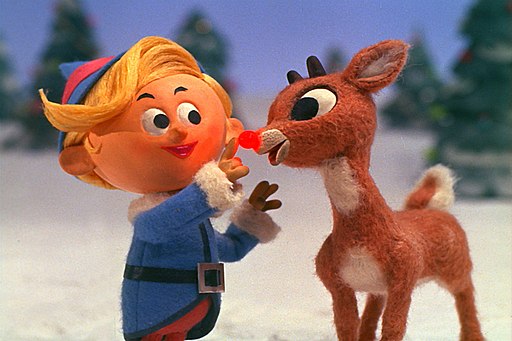This post contains affiliate links - using affiliate links from Homeschool Coffee Break helps fuel this blog and our homeschool - thank you!
In the creative writing class I teach at our co-op, we've been learning about setting, themes, characters, and conflict. We discuss stories we've read as well as movies to find examples of these story elements. For example, when we worked on themes and the fairy tale genre, we watched The Princess Bride in class and looked for the different fairy tale motifs and characters. As I was working on lesson plans a couple weeks ago, I realized that if I went with my original plan, we would have been smack in the middle of a chapter on dialogue when we took our holiday break, and I did not want to break that chapter up if it wasn't necessary. So I figured out a way to review what we've learned so far using familiar Christmas specials!
I decided on the classic Rudolph the Red Nosed Reindeer to watch, and because everyone is familiar with it, we also discussed How the Grinch Stole Christmas (based on the book - How the Grinch Stole Christmas!
(based on the book - How the Grinch Stole Christmas! ). Rudolph has plenty of examples of fairy tale motifs such as the hero's journey, an impossible task, and sets of threes (Rudolph, Hermey, and Yukon Cornelius are the set of three characters on the journey, for instance.). The Grinch is a great example of dramatic character development.
). Rudolph has plenty of examples of fairy tale motifs such as the hero's journey, an impossible task, and sets of threes (Rudolph, Hermey, and Yukon Cornelius are the set of three characters on the journey, for instance.). The Grinch is a great example of dramatic character development.
We started with some discussion about The Grinch, using some of these ideas:
Empathetic Lead - The Grinch is a great empathetic lead! Because he's so villainous right from the start, it's interesting that readers and viewers have a sort of affection for him - that's what we mean by an empathetic lead. The Grinch is obviously the lead character of the story, but he's also the bad guy. We've learned that it's important for that lead character in a story to be empathetic to readers very early, so that readers will take an interest and keep turning pages. It can be a challenge to make a bad guy without many redeeming qualities likable and relatable enough for readers to keep going. (Our example of this in class a few weeks ago was Tony Stark in the opening four minutes of the movie Iron Man - he's a selfish, sarcastic, rude womanizer, and a weapons dealer without any scruples; yet as viewers we rather like him. Why? He's the viewpoint character, he's funny, he is obviously trying to put the soldiers at ease around him and entertain them, and their reactions to him let us know that they aren't offended by his attitude or sexist comments. And he becomes a victim in that opening, and we want to know if and how he survives and changes.) The Grinch, likewise, is quite detestable, but we like him! What makes the Grinch an empathetic lead? He's the viewpoint character. We may wonder what happened to make him so grinchy. We may pity him a bit because he's isolated and alone, which makes him vulnerable. And in a subtle way, we see him as a bit of a victim as a result, but he doesn't act like a victim. And he has a pet dog! Why does the dog stay with him? He must care for the dog in some way.
Character Arc - Talk about a strongly curved character arc! Character Arc is how a character changes from the opening of the story to the end, and the Grinch changes a lot. He starts out as a grumpy, malicious hermit that hates Christmas and everything about it; and by the end he's quite cheerful and jolly, and he himself carves the roast beast. What causes the Grinch to change? The conflicts, of course! The conflicts and the tension in the story are created by the Grinch, in his attempt to stop Christmas from coming to Whoville. The Grinch resents the happiness of the Whos, and steals all their gifts and decorations. There's a risk - the unspoken question of what would happen if he gets caught, which is heightened when Cindy Lou questions him - and there's a time limit - he has to get it all done before the Whos wake up. Those are elements that create tension. The Grinch's inner conflict reaches its climax when he is dangling over the precipice and puzzles over how Christmas came even without the packages and bows. There's a sort of time limit there too, because his character change has to happen before the sleigh drops off the mountain. And there's also tension in how he is affected emotionally - his heart grows three sizes.
Empathetic Lead - Rudolph is a different kind of empathetic lead. He earns our affection easily because he's cute and little and is picked on because he's different. He also displays courage and competence, and he cares deeply for other characters. He's not only bullied, but as the story unfolds he is also in danger. He is alone and vulnerable, was wounded in childhood, and is an underdog. All characteristics that encourage empathy.
Conflict - The conflict starts early, when Rudolph is rejected and picked on. This causes him to decide to strike out on his own, and a lead character 'leaving town' is another source of conflict. The journey sets up a number of elements that create tension - there's constant risk of failure, which would put him and his friends in danger. It affects him emotionally, as he sees others fitting in and finding a place, but there doesn't seem to be a place for him; and as he sees that his glowing nose sometimes puts those he cares about in danger.
Character Arc - Rudolph's character arc may not be a dramatic as the Grinch's, but he does change. He gains confidence, matures, and he makes friends. He learns (as do some of the other characters) that something that makes him different isn't necessarily a bad thing; because it can be used for good. The conflicts highlight his good qualities and give him opportunities to grow and gain further empathy.
Major Dramatic Question - this is the most important thematic question that readers (or viewers) ask as a story opens, and must be answered in some way in order for the story to be satisfying. In Rudolph the Red-Nosed Reindeer, we think the MDQ might be: Will Rudolph find acceptance and fit in?
We might also talk about character motivation - what makes the lead characters tick? What drives them? What do they most want? In upcoming chapters as we carry on in our Writing course, we'll learn about themes, and we might ask what the themes are in these two stories. I'd suggest that for the Grinch, the theme might be "Christmas doesn't come from a store" and for Rudolph, perhaps it might be something like "Everyone has something important to contribute".
While these classic Christmas movies are still fresh in your mind, you might want to discuss some of these elements of fiction with your kids. Although the class I teach and the text we're using is for high school age, middle school students and younger will be able to understand some of these ideas too. How about asking some of these questions about other classic Christmas specials or movies, like The Year Without A Santa Claus, Elf, or The Santa Clause?
If you're interested in the text we are using, it's Writing Fiction [in High School]: Bringing Your Stories to Life! by Sharon Watson, and you can find out more about it in my post Writing Fiction in High School (Blogging Through the Alphabet)
by Sharon Watson, and you can find out more about it in my post Writing Fiction in High School (Blogging Through the Alphabet)
©2006-2018 Homeschool Coffee Break. All rights reserved. All text, photographs, artwork, and other content may not be reproduced or transmitted in any form without the written consent of the author. http://kympossibleblog.blogspot.com/
We are a participant in the Amazon Services LLC Associates Program, an affiliate advertising program designed to provide a means for us to earn fees by linking to Amazon.com and affiliated sites.
















































0 comments:
Post a Comment
I love comments! It's like visiting over a virtual cup of coffee.